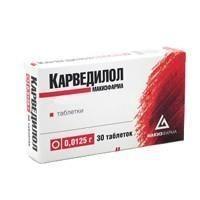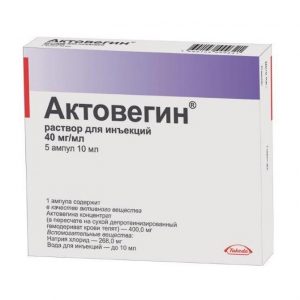Description
Latin name
Carvedilol
Release form
Tablets.
Packaging
In a blister pack of 10 tablets. In a cardboard box 3 blisters.
Pharmacological action
Carvedilol – beta 1 -, beta 2-blocker. Alpha 1-blocker. It has a combined non-selective beta-adrenergic blocking, alpha 1 -adrenergic blocking and antioxidant effect. Is the vasodilating effect mainly associated with blockade 1 -adrenoreceptors. Thanks to vasodilation, it reduces the OPSS. It has no internal sympathomimetic activity and, like propranolol, has a membrane stabilizing effect.
Eliminates free oxygen radicals.
The combination of the vasodilator action and beta-adrenergic blocking properties of carvedilol leads to that in patients with arterial hypertension, a decrease in blood pressure is not accompanied by a simultaneous increase in OPSS, which is noted when taking beta-blockers. Heart rate decreases slightly, renal blood flow and renal function remain. Since peripheral blood flow is maintained, cooling of the extremities is very rare, unlike patients who are treated with beta-blockers.
The antihypertensive effect develops rapidly – 2-3 hours after a single dose and lasts for 24 hours. With prolonged treatment, the maximum effect is observed after 3-4 weeks.
In patients with coronary artery disease, carvedilol has anti-ischemic and antianginal effects. Reduces pre- and afterload on the heart. It does not have a pronounced effect on lipid metabolism and the content of potassium, sodium and magnesium ions in plasma.
In patients with impaired left ventricular function and / or circulatory failure, carvedilol has a beneficial effect on hemodynamic parameters: it increases the ejection function of the left ventricle and reduces its size.
Carvedilol has a beneficial effect on the hemodynamics of the heart and the ejection fraction of the left ventricle in both dilated cardiomyopathy and ischemic heart failure. With heart failure, end-systolic and end-diastolic volume decreases, as well as peripheral and pulmonary vascular resistance. The ejection fraction and cardiac index do not change with normal heart function.
In case of dysfunction of the left ventricle, alpha 1 -adrenergic blocking action of carvedilol leads to the expansion of arterial and, to a lesser extent, venous vessels. Established that with an additional prescription against the background of cardiac glycosides, ACE inhibitors and diuretics, carvedilol reduces the mortality rate, slows the progression of the disease and improves the general condition of the patient, regardless of the severity of the disease. The effect of carvedilol is more pronounced in patients with tachycardia (heart rate more than 82 beats / min) and a low ejection fraction (less than 23%).
During treatment with carvedilol, the ratio of cholesterol-HDL / LDL does not change.
Indications
– Arterial hypertension in the form of mono – or combination therapy (in combination with thiazide diuretics).
– Stable angina pectoris.
– Chronic heart failure in combination with diuretics, digoxin, or ACE inhibitors.
Contraindications
– Chronic heart failure at the stage of decompensation.
– SSSU.
– AV block II and III degree, with the exception of patients with an artificial pacemaker.
– Severe bradycardia (heart rate less than 50 beats / min).
– Cardiogenic shock, collapse.
– Bronchial asthma.
– Severe impairment of liver function.
– Metabolic Acidosis.
– The joint intravenous administration of verapamil, diltiazem or other antiarrhythmic drugs (especially class I).
– Pregnancy.
– Lactation (breastfeeding).
– Age under 18 years of age (efficacy and safety not established).
– Hypersensitivity to the drug.
Precautions:
– Diabetes.
– Hypoglycemia.
– Thyrotoxicosis.
– Pheochromocytoma (only stabilized by the appointment of alpha-blockers).
– Occlusive peripheral vascular disease.
– 1st degree AV block.
– Chronic obstructive pulmonary disease.
– Prinzmetal’s angina pectoris.
– Psoriasis.
– Impaired renal function.
– Depression.
– Myasthenia gravis.
– Treatment with alpha-blockers and alpha-blockers.
– Concomitant use with digitalis preparations, diuretics and / or MAO inhibitors.
– Old age.
Use during pregnancy and lactation
The drug is contraindicated in pregnancy.
If it is necessary to use the drug Carvedilol Sandoz during lactation, breast-feeding should be canceled.
Composition
1 tablet contains: carvedilol 12.5 mg.
Excipients: iron oxide yellow, lactose monohydrate, microcrystalline cellulose, crospovidone, povidone K30, colloidal silicon dioxide, magnesium stearate.
Dosage and administration
Carvedilol is taken orally with plenty of fluids.
Carvedilol should be taken with meals (to reduce the risk of orthostatic hypotension).
Arterial hypertension: the initial dose is 12.5 mg 1 time / day (in the morning after breakfast) for the first 2 days, then 25 mg 1 time / day. If necessary, after 14 days the dose may be increased. The maximum dose is 50 mg / day in 1 or 2 doses (morning and evening). In elderly patients, in some cases, a dose of 12.5 mg may be effective.
Angina pectoris: the initial dose is 12.5 mg 2 times / day for the first 2 days, then 25 mg 2 times / day (morning and evening). If necessary, after 7-14 days, the daily dose can be increased to a maximum of 100 mg / day, divided into 2 doses. In elderly patients, the maximum daily dose is 50 mg, divided into 2 doses.
Chronic heart failure: the dose is selected individually, conducting careful monitoring. You should monitor the condition of the patient during the first 2-3 hours after the first dose or after the first increased dose. Dose and purpose of other drugs, such as digoxin, diuretics and ACE inhibitors should be fixed before the appointment of the drug Carvedilol Sandoz.
The recommended starting dose is 3.125 mg 2 times / day for 14 days. With good tolerability of the drug and the need to increase the dosage, the drug is prescribed at a dose of 6.25 mg 2 times / day, then up to 25 mg 2 times / day. Patients are prescribed the maximum tolerated dose. The maximum recommended dose is 25 mg 2 times / day for patients with body weight up to 85 kg and 50 mg 2 times / day for patients with body weight over 85 kg.
At the beginning of treatment and prior to each dose increase, the patient’s condition should be monitored, as may worsen the course of heart failure. Fluid retention may develop, and due to the presence of a vasodilating effect, arterial hypotension and lethargy. With fluid retention, the dose of diuretics should be increased, in addition, a temporary dose reduction of the drug Carvedilol Sandoz may be required. Sometimes a temporary cessation of treatment is required.
Drug Interaction
When co-administered with Carvedilol Sandoz with catecholamine depleting agents (reserpine, MAO inhibitors), severe bradycardia and hypotension may develop.
Concurrent administration of carvedilol with ACE inhibitors, thiazide diuretics, and vasodilators administered at the same time can lead to a dramatic drop in blood pressure.
Carvedilol enhances the action of insulin and sulfonylureas (simultaneously masking or reducing the severity of symptoms of hypoglycemia, reducing the breakdown of liver glycogen to glucose). When administered with insulin or oral hypoglycemic agents, blood glucose should be monitored.
When co-administered with CYP2D6 isoenzyme inhibitors (quinidine, fluoxetine, propafenone), the R (+) enantiomer concentration of carvedilol may increase.
Co-administration of carvedilol with antiarrhythmic agents (especially class I) and slow calcium channel blockers (verapamil, diltiazem) can provoke marked arterial hypotension and heart failure. In / in the introduction of these drugs together with the use of carvedilol is contraindicated.
Carvedilol increases the concentration of digoxin, which requires that its concentration be monitored. concomitant administration with cardiac glycosides may lead to AV blockade.
General anesthetics enhance the negative inotropic and hypotensive effects of carvedilol.
Phenobarbital and rifampicin accelerate metabolism and decrease carvedilol plasma concentrations.
Microsomal oxidation inhibitors (cimetidine), diuretics and ACE inhibitors increase concentration and enhance the antihypertensive effect of carvedilol.
Carvedilol delays cyclosporine metabolism.
Overdose
Symptoms: pronounced decrease in blood pressure (systolic pressure 80 mmHg and below). bradycardia (less than 50 beats / min), respiratory dysfunction (bronchospasm), chronic circulatory failure, cardiogenic shock, cardiac arrest
Treatment: for the first 2 hours, induce vomiting and wash the stomach. Overdose requires intensive treatment. The patient should be in a position with his legs up (in the position of Trendelenburg). The antidote to beta-blockade action is orciprenaline or isoprenaline at a dose of 0.5-1 mg / v and / or glucagon at a dose of 1-5 mg (maximum dose of 10 mg). Severe hypotension is treated with parenteral fluid administration and the re-introduction of epinephrine (adrenaline) at a dose of 5-10 mg (or its infusion at a rate of 5 μg / min). In case of excessive bradycardia, atropine at a dose of 0.5-2 mg is prescribed. To maintain cardiac output, fasting glucose (within 30 seconds) is administered, followed by a continuous infusion of 2-5 mg / h. If peripheral vasodilator action (warm limbs, in addition to significant arterial hypotension) prevails, it is necessary to appoint norepinephrine in repeated doses of 5-10 mcg or in the form of infusion – 5 mcg / min. For the treatment of bronchospasm appoint beta-blockers (in the form of aerosol or / in) or aminophylline in / in. If seizures develop, the slow introduction of diazepam or clonazepam is recommended. In severe cases of intoxication, when the symptoms of shock dominate, treatment with antidotes should continue until the condition of the patient stabilizes, taking into account T 1/2 carvedilol for 6-10 hours. In the conditions of resuscitation, monitor the indicators of vital organs.
Storage conditions
Store at a temperature not exceeding 25 ° C.
Expiration
3 years.
Dosage form
dosage form
tablets
Sandoz, Switzerland




